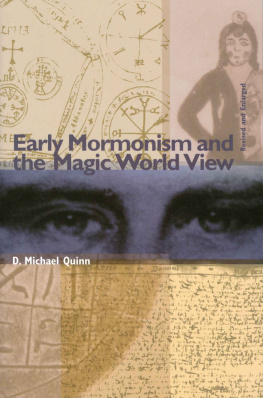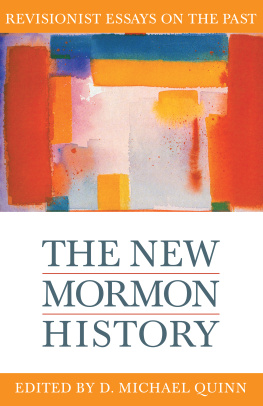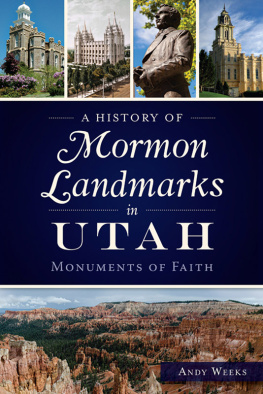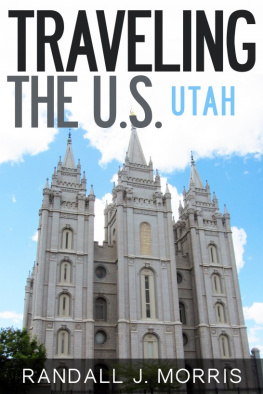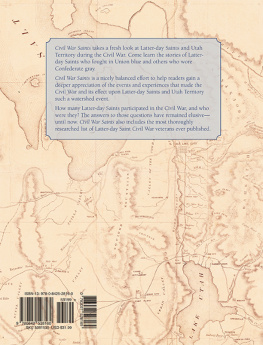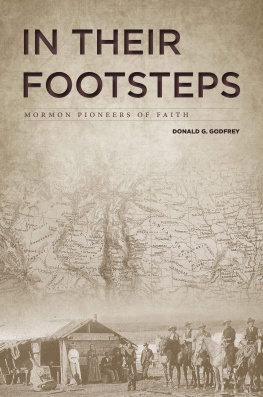The Mormon Hierarchy
Wealth & Corporate Power
The
Mormon Hierarchy
Wealth & Corporate Power
D . Michael Quinn
Signature Books | 2017 | Salt Lake City
In memory of Leonard J. Arrington ,
Mormonisms finest historian,
my mentor, and a constant friend.
2017 Signature Books Publishing LLC. All rights reserved. Signature Books is a registered trademark. Printed in the USA on paper certified by the Sustainable Forestry Initiative. Jacket design by Traci OVery Covey. Composition by Jason Francis. www.signaturebooks.com.
First Edition | 2017
Library of Congress Cataloging-in-Publication Data
Names : Quinn, D. Michael, 1944 author.
Title: The Mormon hierarchy : wealth and corporate power / D. Michael Quinn.
Description: Salt Lake City : Signature Books, 2017. | Includes bibliographical references and index.
Identifiers: LCCN 2017002582 | ISBN 9781560852353 (alk. paper)
Subjects: LCSH: Mormon ChurchHistory. | Church of Jesus Christ of Latter-day SaintsHistory. | Mormon ChurchFinanceHistory. | Church of Jesus Christ of Latter-day SaintsFinanceHistory. | Mormon ChurchGovernmentHistory. | Church of Jesus Christ of Latter-day SaintsGovernmentHistory.
Classification: LCC BX8611 .Q58 2017 | DDC 289.3/32dc23 LC record available at
https: / / lccn.loc.gov/2017002582
Contents
acknowledgements
The narrative chapters of this book have been fleshed out from the twenty-one appendixes included at the end of the volume, and contain information from a variety of sources. I researched files for each business in the county and state of its incorporation or registration, in published and manuscript versions of R. G. Dun rating books from 1864 onward, annual trade publications and guides, original newspaper files, city directories, company histories, board of directors minutes, business directories, city and county tax assessment rolls, nineteenth-century Internal Revenue Service manuscript assessments, biographies, diaries, manuscript correspondence, and local histories. These have been supplemented in recent years by internet search engines and by researching websites such as Utah Digital Newspapers and Chronicling America: Historic American Newspapers . Many of my notes from the above sources are available in my research files at the Beinecke Library, Yale University. When there were discrepancies within the data, I resolved them as best I could.
I am indebted to hundreds of archivists and others in city offices, county court houses, and state archives who allowed me to examine vaults, attics, basements, and remote storage facilities for nearly forgotten documents of corporations and business licenses. Only through receiving stack privileges at the Library of Congress was I able to do a comprehensive survey of nearly all the relevant pre-1933 annual rating books, trade publications, and city directories for the United States, Canada, and the United Kingdom. I also found significant information in corporate documents housed in public libraries and archives, and in vaults of functioning businesses. Singular gratitude is due to the Claremont School of Theologys Library for the many months of my hours-daily use of its electronic resources in updating and finalizing the appendixes.
The following archivists and other professionals deserve special thanks: K. Haybron Adams, Mary Ester Allers, Alan Barnett, Meghan Beutler, Ron Bitton, Daniel J. Boorstin, L. Madelon Brunson, Maxine Burnett, Jay Burrup, Blake Burton, Alfred L. Bush, Ann Buttars, Tony Castro, Everett L. Cooley, Randy Dixon, Larry W. Draper, G. Homer Durham, Della Dye, Michele Elnicky, Lee Erickson, Max J. Evans, Oakley S. Evans, Chad J. Flake, Juana Frisbie, Duffy Goble, Isma C. Gonzales, Archie Hanna, Linda Haslam, Jay M. Haymond, Jonathan David Hepworth, Pat Herman, Richard P. Howard, Kim Hunter, T. Harold Jacobsen, Jeffery O. Johnson, Walter R. Jones, Lisa Lineback Kamerath, Lezann V. Keshmiri, James L. Kimball, Sally Koch, Sarah Langsdon, Robert C. Lively, Linda Lokovic, Lupita Lopez, W. Grant McMurray, Christine Marin, George Miles, Douglas Misner, Paula Mitchell, Alan Morrell, Thomasina Morris, John Netto, Heidi Orchard, Mary Price, Clint Pumphrey, Ronald Read, Martin Ridge, Ronald E. Romig, Dennis Rowley, Jenny St. Clair, Peter Schmid, Donald T. Schmidt, Janet Seegmiller, John R. Sillito, A. J. Simmonds, Roy W. Simmons, Larry Skidmore, Robert Allen Skotheim, William W. Slaughter, Melvin T. Smith, Martha Ross Stewart, Betsey Stout, Stephen C. Sturgeon, Rod Swaner, Linda Thatcher, Gregory C. Thompson, Gary Topping, Distaquaine Tuihalamaka, Greg Walz, Ronald G. Watt, Brad Westwood, David J. Whittaker, and Val E. Wilson.
Although I did the bulk of this research alone for decades, the following persons doublechecked parts of my business research, gave me access to their own research files, researched specific business and finance documents at my request, or made helpful suggestions: Thomas G. Alexander, James B. Allen, Leonard J. Arrington, Steven G. Barnett, Gary James Bergera, J. Alan Blodgett, David F. Boone, Janice Darley Quinn Carter, James G. Clawson, Chris Doss, Andrew F. Ehat, Jani Fleet, Craig L. Foster, Lawrence Foster, Van C. Gessel, Lorine S. Goodwin, Victoria Grover-Swank, Maxine Hanks, Harvard S. Heath, Patricia Quinn Honey, E. Leo Lyman, H. Michael Marquardt, D. Gene Pace, Wayne Parker, Ron Priddis, P. T. Reilly, Dennis S. Sears, Jan Shipps, Andrew F. Smith, Derek Snarr, William R. Spence, Kreighton (Kraig) Stephens, Raymond W. Taylor, Ken Williams, and Larry T. Wimmer.
With appreciation,
D. Michael Quinn
Chapter 1.
Personal Wealth
The Past Is Prologue
There have been major changes in personal wealth, business enterprise, and institutional finance within the Mormon hierarchy since 1830. After Western New Yorks rising prophet Joseph Smith Jr. published the Book of Mormon in late March of that year, non-believers coined the nickname Mormonites to describe his followers.
However, just as first-century believers eventually embraced the derogatory nickname Christian,
Financially, Mormonism began with a personal loan for a significant sum. Before Smiths book of scripture could be printed, New Yorks reluctant publisher E. B. Grandin of Palmyra required collateral of $3,000 in August 1829 to secure the costs of printing and binding. Despite the opposition of his wife Lucy (mother of their three children), believer Martin Harris mortgaged his farm for that amount.
In early Mormonism, the individual congregation was initially called a branch and eventually a ward, similar to parishes in traditional Christianity. Secondly, groups of several wards were formed into a stake, similar to a diocese in Catholic and Episcopal traditions. LDS bishops presided over wards, while stake presidents led stakes.
At the churchs founding in April 1830, twenty-four-year-old Joseph Smith Jr. was sustained as its first elder and similarly aged Oliver Cowdery became second elder.
Thus began a formal, stratified hierarchy of officers with church-wide jurisdiction. This distinguished them from ordained and set-apart officers who had only congregational or regional jurisdictions. Eventually called general authorities,
The Presiding Bishopric is the hierarchy echelon most identified with economic and financial roles. Nonetheless, this bishop and his counselors, like all other general authorities, have given devotional sermons and religious instructions, personally counseled individual Mormons, and rendered judgment about matters both spiritual and temporal (D&C 102:32). Although this revelatory phrase suggests that the two realms be distinct, Mormonism merged them (chapter 2).
This book examines the finances of these LDS leaders and their financial policies from 1830 to 2010, expanding those topics far beyond their discussion in my two previous volumes in the Mormon Hierarchy series. To make these matters more understandable to twenty-first-century readers, this volume often states what the equivalent of US dollars in the nineteenth century would be in terms of purchasing power in 2010, the final year of this books emphasis. For example, even trained historians might currently think that an annual income of $10,000 was modest for the year 1899, when it was actually equivalent to $271,000 in 2010. Rather than my own estimate of comparative worth, the financial equivalents are derived from the Consumer Price Index on the internet.
Next page

